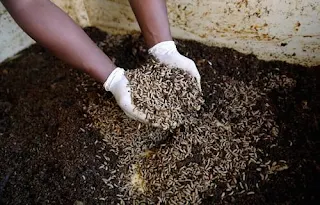MAGGOT PRODUCTION
With the rise in prices of commercial fish feed, alternative fish feed sources are sorted, one of such is maggot which serves as live feed to cultured fish, aside being an alternative to feed fish it is use to feed various poultry like chicken, turkey and duck, maggot also serves as an excellent replacement for fishmeal in feed production, it is a potential solution to waste management on the farm because the waste is the raw material to produce maggots, maggot also provide fertilizer for crop production. Maggot is easy to produce and is affordable even by local farmers. Maggot contains the following nutrient: Protein, Lysine, Calcium, Potassium, Phosphorus, Magnesium, Copper, Zinc, Fatty Acid, Amino Acids and Iron.
HOW TO START PRODUCING MAGGOT:The “Housefly maggots” are cultured on various organic wastes such as: poultry manure, pig manure, using developed culture units.
SELECT LOCATION: The location should depend on the available land or space and the quantity the farmer want, proximity to culture mediums should also be considered.
CONSTRUCT YOUR HOUSING : Construct housing to suit your space and scale of production. You can construct a small open house with a roof. The floor of the pen house should be floored with concrete. Construct drainage around the pen house to prevent termites, lizard and rats from accessing your pen and causing damage.
COLLECT YOUR RAW MATERIALS: Poultry dropping is the most popular raw material for maggot production. The poultry dropping are gotten from the poultry.
PRODUCTION PROCESS:
Adult female flies lay up to 2500 eggs under controlled condition.
They lay their eggs on the substrate (Poultry Dropping)
The eggs hatch after 8 to 12 hours.
The larval stage lasts about 5 days while the pupae stage for 4 to 5 days.
The housefly has 6 days cycle under controlled conditions.
Water the substrate daily to increase production.
Maggot is ready to harvest within 4-5days.
FEEDING:
The adult fly feeds mainly on decaying organic matter.
Maggots feed for 4-5 days and then migrate to pupate in a dry place. ,
The flies mate and lay eggs between feeding periods.
450 grams of fresh manure can feed 1500 maggots
HARVESTING:
You can harvest maggot with three different methods;
The flotation method where the manure is mixed with water and the larvae and pupae float out to be collected with a sieve.
The screening method where the manure is spread in a thin layer on a sieve (3 mm) placed over a basin under sunlight: the larvae try to escape the light by passing through the screen and fall into the basin.
The self - collect method is where the larva is trapped by collecting tanks when the larva is trying to escape.


Comments
Post a Comment